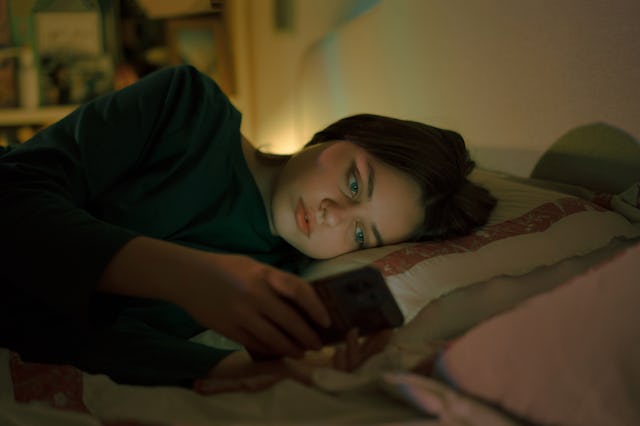The Type Of Screen Time Your Teen Gets Before Bed Matters
A new study has found there's a difference between "interactive" screen time and "passive" screen time.

We get it, we get it, we get it: too much screen time isn’t great for our kids. And screen time right before bed is the worst kind of screen time of them all. But are all types of screen time created equal?
A new study out of Penn State, published last week in the Journal of Adolescent Health, shows that what your kids are doing on their screens before bed matters significantly. Specifically, passive screen time, like watching a TV show, watching TikTok, or surfing the internet, is better for kids’ sleep than interactive screen time, like texting, social media, or video games.
The study followed 475 adolescents for a week throughout their days and nights, tracking their screen time, types of screen time, and other activities. Screen time was broken down into different categories, including email (ha!), instant messaging, texting, social media, TV and movies, videos, and surfing the internet. Special attention was put on screen time in the hour before bed, and kids’ sleep was monitored with a tracking device worn on their wrists.
The teens spent an average of two hours per day texting and messaging, 1.7 hours watching video or shows, 1.3 hours playing video games, and less than an hour on the web.
They slept for an average of 7.8 hours per night.
Who lost the most sleep? The teens who were talking and texting in the hour before bed took an average of 30 minutes longer to fall asleep.
And when you talk about teen sleep, every minute literally counts.
“For a child, losing 15 minutes of sleep at night is significant,” David Reichenberger, postdoctoral scholar at Penn State and lead author on the study, told Science Daily. “It's especially difficult when they have to get up in the morning for school; if they're delaying their sleep, they can't make up for it in the morning. Without adequate sleep, kids are at increased risk of obesity, as well as impaired cognition, emotion regulation and mental health."
The study also found that for every hour that kids used screens to communicate with friends during the day, they lost an average of 11 minutes of sleep a night. For every hour of video games they played, they lost 9 minutes of sleep a night.
Why are passive forms of screen watching seemingly better than interactive forms in the hour before bed?
"It could be that these more passive activities are less mentally stimulating than interactive activities, like texting and video game playing." Anne-Marie Chang, associate professor of biobehavioral health and study co-author, told Science Daily.
And that makes sense: Teens could be getting worked up about drama and social interactions while being active online, while those chilling out watching a show are getting their brains more ready for bed.
"It's a tricky situation," Chang said in the interview. "These tools are really important to everyone nowadays, so it's hard to put a limit on them, but if you're really looking out for an adolescent's health and well-being, then you might consider limiting the more interactive activities, especially in the hour before bed."
Of course, the best ways to get to bed don’t involve screens at all. Another recent study of people of all ages found that any amount of screen time in the two hours before bed can ruin the melatonin surge that gets your body ready to sleep. A third study found that a kids’ quality of sleep also goes down if they’re on screen before they tuck in.
What should kids do instead? The Sleep Foundation suggests a calming nighttime routine (sounds so easy, right?), dim lighting, and screen-free activities like reading a book, writing in a journal, or making some art.
But if screens are part of the conversation, try suggesting a light TV show or have family movie time instead of more stimulating video games, DMing and social media.
This article was originally published on